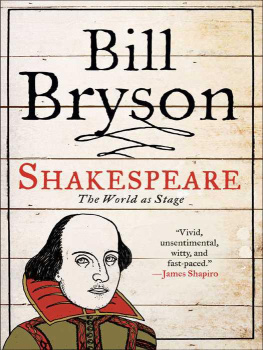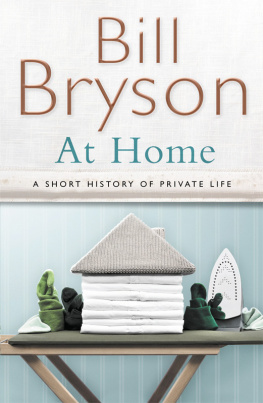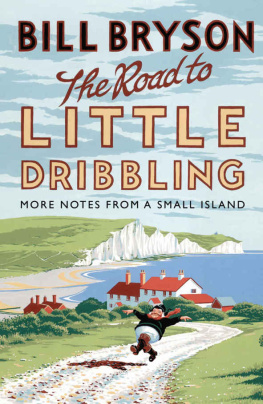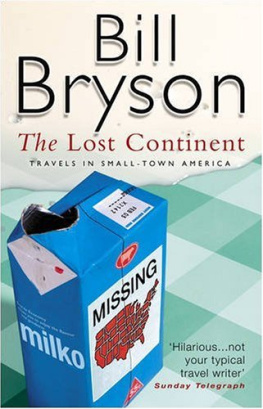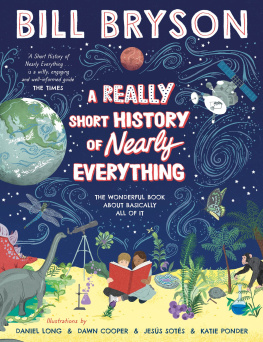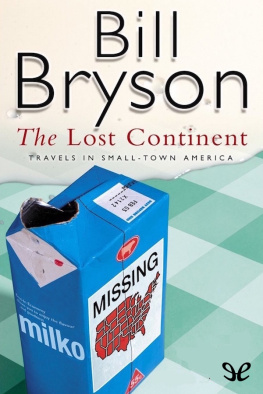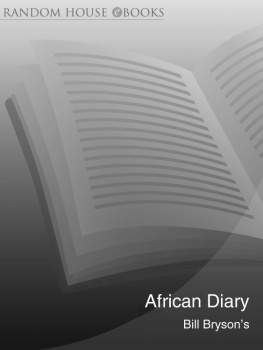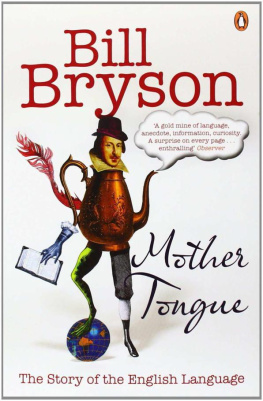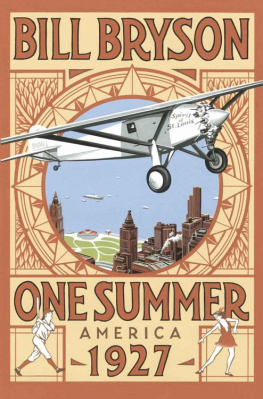Bill Bryson - Shakespeare: The World as Stage (Eminent Lives)
Here you can read online Bill Bryson - Shakespeare: The World as Stage (Eminent Lives) full text of the book (entire story) in english for free. Download pdf and epub, get meaning, cover and reviews about this ebook. year: 2007, publisher: Eminent Lives, genre: Non-fiction. Description of the work, (preface) as well as reviews are available. Best literature library LitArk.com created for fans of good reading and offers a wide selection of genres:
Romance novel
Science fiction
Adventure
Detective
Science
History
Home and family
Prose
Art
Politics
Computer
Non-fiction
Religion
Business
Children
Humor
Choose a favorite category and find really read worthwhile books. Enjoy immersion in the world of imagination, feel the emotions of the characters or learn something new for yourself, make an fascinating discovery.
- Book:Shakespeare: The World as Stage (Eminent Lives)
- Author:
- Publisher:Eminent Lives
- Genre:
- Year:2007
- Rating:4 / 5
- Favourites:Add to favourites
- Your mark:
- 80
- 1
- 2
- 3
- 4
- 5
Shakespeare: The World as Stage (Eminent Lives): summary, description and annotation
We offer to read an annotation, description, summary or preface (depends on what the author of the book "Shakespeare: The World as Stage (Eminent Lives)" wrote himself). If you haven't found the necessary information about the book — write in the comments, we will try to find it.
Shakespeare: The World as Stage (Eminent Lives) — read online for free the complete book (whole text) full work
Below is the text of the book, divided by pages. System saving the place of the last page read, allows you to conveniently read the book "Shakespeare: The World as Stage (Eminent Lives)" online for free, without having to search again every time where you left off. Put a bookmark, and you can go to the page where you finished reading at any time.
Font size:
Interval:
Bookmark:
The World as Stage
Eminent Lives

To Finley and Molly and in memory of Maisie
Chapter One
In Search of William Shakespeare
Chapter Two
The Early Years, 15641585
Chapter Three
The Lost Years, 15851592
Chapter Four
In London
Chapter Five
The Plays
Chapter Six
Years of Fame, 15961603
Chapter Seven
The Reign of King James, 16031616
Chapter Eight
Death
Chapter Nine
Claimants
Eminent Lives, a series of brief biographies by distinguished authors on canonical figures, joins a long tradition in this lively form, from Plutarchs Lives to Vasaris Lives of the Painters , Dr. Johnsons Lives of the Poets to Lytton Stracheys Eminent Victorians. Pairing great subjects with writers known for their strong sensibilities and sharp, lively points of view, the Eminent Lives are ideal introductions designed to appeal to the general reader, the student, and the scholar. To preserve a becoming brevity which excludes everything that is redundant and nothing that is significant, wrote Strachey: That, surely, is the first duty of the biographer.
B EFORE HE CAME INTO a lot of money in 1839, Richard Plantagenet Temple Nugent Brydges Chandos Grenville, second Duke of Buckingham and Chandos, led a largely uneventful life.
He sired an illegitimate child in Italy, spoke occasionally in the Houses of Parliament against the repeal of the Corn Laws, and developed an early interest in plumbing (his house at Stowe, in Buckinghamshire, had nine of the first flush toilets in England), but otherwise was distinguished by nothing more than his glorious prospects and many names. But after inheriting his titles and one of Englands great estates, he astonished his associates, and no doubt himself, by managing to lose every penny of his inheritance in just nine years through a series of spectacularly unsound investments.
Bankrupt and humiliated, in the summer of 1848 he fled to France, leaving Stowe and its contents to his creditors. The auction that followed became one of the great social events of the age. Such was the richness of Stowes furnishings that it took a team of auctioneers from the London firm of Christie and Manson forty days to get through it all.
Among the lesser-noted disposals was a dark oval portrait, twenty-two inches high by eighteen wide, purchased by the Earl of Ellesmere for 355 guineas and known ever since as the Chandos portrait. The painting had been much retouched and was so blackened with time that a great deal of detail was (and still is) lost. It shows a balding but not unhandsome man of about forty who sports a trim beard. In his left ear he wears a gold earring. His expression is confident, serenely rakish. This is not a man, you sense, to whom you would lightly entrust a wife or grown daughter.
Although nothing is known about the origin of the painting or where it was for much of the time before it came into the Chandos family in 1747, it has been said for a long time to be of William Shakespeare. Certainly it looks like William Shakespearebut then really it ought to, since it is one of the three likenesses of Shakespeare from which all other such likenesses are taken.
In 1856, shortly before his death, Lord Ellesmere gave the painting to the new National Portrait Gallery in London as its founding work. As the gallerys first acquisition, it has a certain sentimental prestige, but almost at once its authenticity was doubted. Many critics at the time thought the subject was too dark-skinned and foreign lookingtoo Italian or Jewishto be an English poet, much less a very great one. Some, to quote the late Samuel Schoenbaum, were disturbed by his wanton air and lubricious lips. (One suggested, perhaps a touch hopefully, that he was portrayed in stage makeup, probably in the role of Shylock.)
Well, the painting is from the right periodwe can certainly say that much, Dr. Tarnya Cooper, curator of sixteenth-century portraits at the gallery, told me one day when I set off to find out what we could know and reasonably assume about the most venerated figure of the English language. The collar is of a type that was popular between about 1590 and 1610, just when Shakespeare was having his greatest success and thus most likely to sit for a portrait. We can also tell that the subject was a bit bohemian, which would seem consistent with a theatrical career, and that he was at least fairly well to do, as Shakespeare would have been in this period.
I asked how she could tell these things.
Well, the earring tells us he was bohemian, she explained. An earring on a man meant the same then as it does nowthat the wearer was a little more fashionably racy than the average person. Drake and Raleigh were both painted with earrings. It was their way of announcing that they were of an adventurous disposition. Men who could afford to wore a lot of jewelry back then, mostly sewn into their clothes. So the subject here is either fairly discreet, or not hugely wealthy. I would guess probably the latter. On the other hand, we can tell that he was prosperousor wished us to think he was prosperousbecause he is dressed all in black.
She smiled at my look of puzzlement. It takes a lot of dye to make a fabric really black. Much cheaper to produce clothes that were fawn or beige or some other lighter color. So black clothes in the sixteenth century were nearly always a sign of prosperity.
She considered the painting appraisingly. Its not a bad painting, but not a terribly good one either, she went on. It was painted by someone who knew how to prime a canvas, so hed had some training, but it is quite workaday and not well lighted. The main thing is that if it is Shakespeare, it is the only portrait known that might have been done from life, so this would be what William Shakespeare really looked likeif it is William Shakespeare.
And what are the chances that it is?
Without documentation of its provenance well never know, and its unlikely now, after such a passage of time, that such documentation will ever turn up.
And if not Shakespeare, who is it?
She smiled. Weve no idea.
If the Chandos portrait is not genuine, then we are left with two other possible likenesses to help us decide what William Shakespeare looked like. The first is the copperplate engraving that appeared as the frontispiece of the collected works of Shakespeare in 1623the famous First Folio.
The Droeshout engraving, as it is known (after its artist, Martin Droeshout), is an arrestinglywe might almost say magnificentlymediocre piece of work. Nearly everything about it is flawed. One eye is bigger than the other. The mouth is curiously mispositioned. The hair is longer on one side of the subjects head than the other, and the head itself is out of proportion to the body and seems to float off the shoulders, like a balloon. Worst of all, the subject looks diffident, apologetic, almost frightenednothing like the gallant and confident figure that speaks to us from the plays.
Droeshout (or Drossaert or Drussoit, as he was sometimes known in his own time) is nearly always described as being from a family of Flemish artists, though in fact the Droeshouts had been in England for sixty years and three generations by the time Martin came along. Peter W. M. Blayney, the leading authority on the First Folio, has suggested that Droeshout, who was in his early twenties and not very experienced when he executed the work, may have won the commission not because he was an accomplished artist but because he owned the right piece of equipment: a rolling press of the type needed for copperplate engravings. Few artists had such a device in the 1620s.
Font size:
Interval:
Bookmark:
Similar books «Shakespeare: The World as Stage (Eminent Lives)»
Look at similar books to Shakespeare: The World as Stage (Eminent Lives). We have selected literature similar in name and meaning in the hope of providing readers with more options to find new, interesting, not yet read works.
Discussion, reviews of the book Shakespeare: The World as Stage (Eminent Lives) and just readers' own opinions. Leave your comments, write what you think about the work, its meaning or the main characters. Specify what exactly you liked and what you didn't like, and why you think so.

